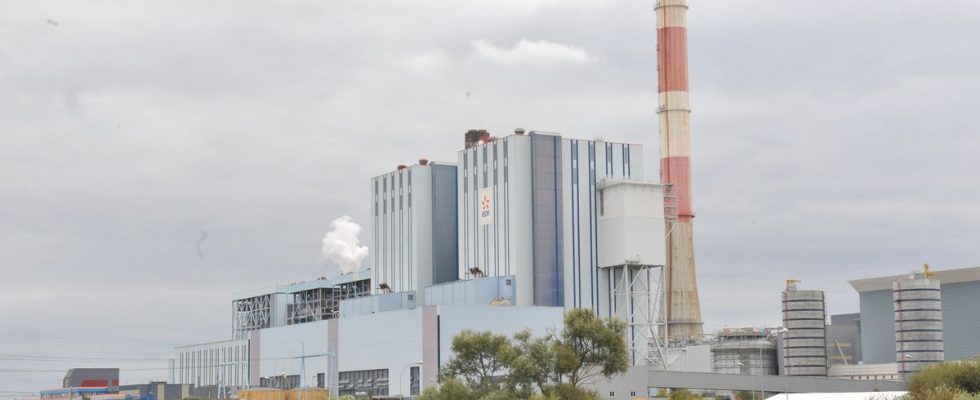Completely get out of coal by 2027… This Monday afternoon, at the end of a meeting of the National Council for Ecological Transition, Emmanuel Macron must present in detail “ecological planning”, this major plan promised in between the two rounds of the presidential election and which should allow France to achieve its environmental objectives.
As of Sunday evening, on the news of TF1 and France 2, the Head of State has already given some guidelines, including that of phasing out coal, a fossil energy with a heavy carbon footprint, within three years.
In fact, the president announced in 2017 the objective of closing before 2022 [la fin de son premier quinquennat] the last four coal-fired power stations that were still operating. In Le Havre, Gardanne (Bouches-du-Rhône), Cordemais (Loire-Atlantique) and Saint-Avold (Moselle). The war in Ukraine and the disruption of Russian gas supplies have changed the situation. If the Le Havre and Gardanne power plants closed in 2021, the operation of the last two has been extended until the end of 2024, in view of very tense winters for energy.
There for help
These two plants are used as a backup solution, feeding the grid to get through peaks – the tensest times on our electricity grid. Typically on certain winter days, when the heating is on at full speed and our electricity production is struggling to keep up with demand. In other words, they already have a very marginal impact on our electricity production. Around 0.6% last year, recalled Electricity Transport Network (RTE), the manager of the French electricity network.
There is still a way out to be found for these two power plants, which between them still employ several hundred people. In his speech on Sunday, the president spoke of converting them to biomass. In other words: the two sites will retain their purpose of producing electricity, but from another fuel.
At the beginning of January, the Cordemais power plant already had its reconversion project, called Ecocombus, validated by the Ministry of Ecological Transition. The plan is to replace a large part of the charcoal with wood pellets produced from pruning, pruning and especially furniture wood residues.
Convert them to biomass by drawing from the surrounding forests?
But will there be enough co-products from the wood sector, locally, to “totally convert to biomass” Saint-Avold and Cordemais, as Emmanuel Macron mentions. HAS Greenpeace, we doubt it. “That’s a bit of the problem with “biomass”, whether it’s wood or agricultural co-products. [déjections, résidus de culture…], explains Nicolas Nace, “Energy Transition” campaign manager for the NGO. Many industries and sectors are banking on this resource to make their transition while the volumes of biomass that we will be able to mobilize remain limited. » In short, there won’t be something for everyone.
Greenpeace then fears what happens next for Saint-Avold and Cordemais: “Are we going to take even more wood from French forests, which are in poor health due to climate change and already subject to pressure from competing uses? Are we going to import this wood and cause deforestation on the other side of the world? », she lists in her press release.
Already complicated transition in Gardanne?
Frédéric Amiel, general coordinator Friends of the Earthrecalls that the United Kingdom and Canada have already made this choice to operate mega-wood-fired power plants. With very mixed results. “Not only is energy efficiency low and these power plants generate significant air pollution, but above all they require very significant wood to operate,” he explains. Waste from sawmills or furniture production is by no means sufficient. These power stations must import part of their wood, and sawmill industries have also developed around them, expressly to supply them with peels produced from trees cut down on the ground. » For Frédéric Amiel, there would be much better things to do with these forests.
NGOs fear this same “headlong flight” for Saint-Avold and Cordemais. This is also the path taken by the old Gardanne coal-fired power station. One of the units has undergone work to operate on biomass from 2018. And its supply plan estimates its annual needs at 850,000 tonnes of wood to operate it, half of which is taken from the region. “Either the removal by 2024 of more than 35% of the forest resources available within a radius of 250 km around the site, or around twenty departments”, warns France Nature Environment Paca. Last March, the Council of State canceled the operating authorization for the plant due to the lack of an impact study on the consequences for the local forest.
Waiting for more details
Nicolas Nace says he is waiting for more details from Emmanuel Macron on the plan designed to make Cordemais and Saint-Avold run entirely on biomass. “It would undoubtedly have been better for a more ambitious reconversion for these two sites,” he already believes. There are many other industrial sectors, hydrogen for example, more promising to develop as part of the ecological transition” But the NGO’s “Energy Transition” campaign manager is already ticking off the 2027 deadline, “very late” in his eyes. “In view of what these two plants represent, today, in our mix, we should have been much more ambitious,” he believes.

